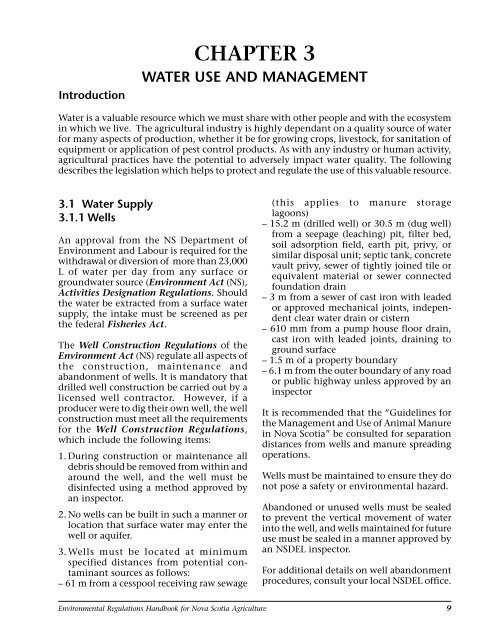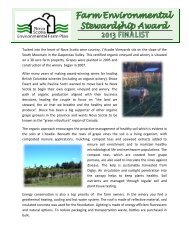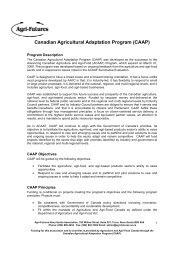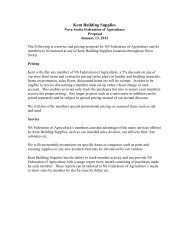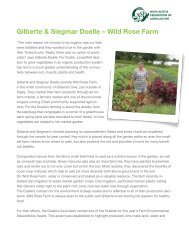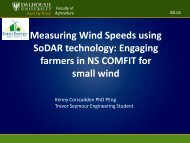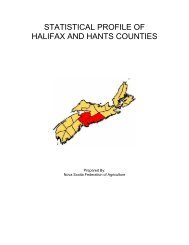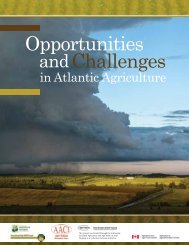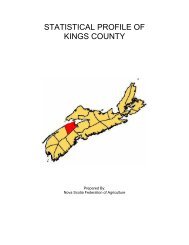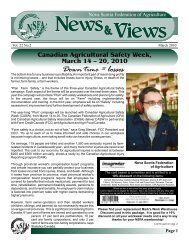Environmental Regulations Handbook for Nova Scotia Agriculture
Environmental Regulations Handbook for Nova Scotia Agriculture
Environmental Regulations Handbook for Nova Scotia Agriculture
You also want an ePaper? Increase the reach of your titles
YUMPU automatically turns print PDFs into web optimized ePapers that Google loves.
Introduction<br />
CHAPTER 3<br />
WATER USE AND MANAGEMENT<br />
Water is a valuable resource which we must share with other people and with the ecosystem<br />
in which we live. The agricultural industry is highly dependant on a quality source of water<br />
<strong>for</strong> many aspects of production, whether it be <strong>for</strong> growing crops, livestock, <strong>for</strong> sanitation of<br />
equipment or application of pest control products. As with any industry or human activity,<br />
agricultural practices have the potential to adversely impact water quality. The following<br />
describes the legislation which helps to protect and regulate the use of this valuable resource.<br />
3.1 Water Supply<br />
3.1.1 Wells<br />
An approval from the NS Department of<br />
Environment and Labour is required <strong>for</strong> the<br />
withdrawal or diversion of more than 23,000<br />
L of water per day from any surface or<br />
groundwater source (Environment Act (NS),<br />
Activities Designation <strong>Regulations</strong>. Should<br />
the water be extracted from a surface water<br />
supply, the intake must be screened as per<br />
the federal Fisheries Act.<br />
The Well Construction <strong>Regulations</strong> of the<br />
Environment Act (NS) regulate all aspects of<br />
the construction, maintenance and<br />
abandonment of wells. It is mandatory that<br />
drilled well construction be carried out by a<br />
licensed well contractor. However, if a<br />
producer were to dig their own well, the well<br />
construction must meet all the requirements<br />
<strong>for</strong> the Well Construction <strong>Regulations</strong>,<br />
which include the following items:<br />
1. During construction or maintenance all<br />
debris should be removed from within and<br />
around the well, and the well must be<br />
disinfected using a method approved by<br />
an inspector.<br />
2. No wells can be built in such a manner or<br />
location that surface water may enter the<br />
well or aquifer.<br />
3.Wells must be located at minimum<br />
specified distances from potential contaminant<br />
sources as follows:<br />
– 61 m from a cesspool receiving raw sewage<br />
(this applies to manure storage<br />
lagoons)<br />
– 15.2 m (drilled well) or 30.5 m (dug well)<br />
from a seepage (leaching) pit, filter bed,<br />
soil adsorption field, earth pit, privy, or<br />
similar disposal unit; septic tank, concrete<br />
vault privy, sewer of tightly joined tile or<br />
equivalent material or sewer connected<br />
foundation drain<br />
– 3 m from a sewer of cast iron with leaded<br />
or approved mechanical joints, independent<br />
clear water drain or cistern<br />
– 610 mm from a pump house floor drain,<br />
cast iron with leaded joints, draining to<br />
ground surface<br />
– 1.5 m of a property boundary<br />
– 6.1 m from the outer boundary of any road<br />
or public highway unless approved by an<br />
inspector<br />
It is recommended that the “Guidelines <strong>for</strong><br />
the Management and Use of Animal Manure<br />
in <strong>Nova</strong> <strong>Scotia</strong>” be consulted <strong>for</strong> separation<br />
distances from wells and manure spreading<br />
operations.<br />
Wells must be maintained to ensure they do<br />
not pose a safety or environmental hazard.<br />
Abandoned or unused wells must be sealed<br />
to prevent the vertical movement of water<br />
into the well, and wells maintained <strong>for</strong> future<br />
use must be sealed in a manner approved by<br />
an NSDEL inspector.<br />
For additional details on well abandonment<br />
procedures, consult your local NSDEL office.<br />
<strong>Environmental</strong> <strong>Regulations</strong> <strong>Handbook</strong> <strong>for</strong> <strong>Nova</strong> <strong>Scotia</strong> <strong>Agriculture</strong><br />
9


